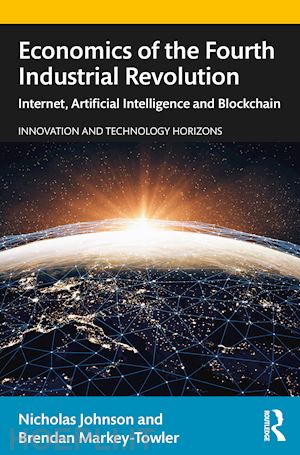List of Figures Acknowledgements Chapter 1 Introduction: how and why to understand the fourth industrial revolution 1 Our approach to the economics of the Fourth Industrial Revolution 2 A preview of our arguments References Part I Industrial revolutions: what they are, why they matter, how to analyse them Chapter 2 Industrial revolutions past, present and future: a brief overview of how we got here and where we’re going 1 From economic stagnation to economic growth 2 Malthusian dynamics and the pre-growth era 3 The Industrial Revolution: The First 4 The Technological Revolution: The Second 5 The Digital Revolution: The Third 6 The Fourth Industrial Revolution References Chapter 3 The telos of industrial revolutions: how what people value drives the adoption of new technologies 1 Means, ends and value 2 A hierarchy of value 2.1 Transcendental value 2.2 Foundational value 2.3 Aspirational value 3 Industrial Revolutions promote higher-order values References Chapter 4 The "Brisbane Club" model: mind, society, economy as complex evolving networks 1 Society and economy as complex evolving networks 2 Formation of socioeconomic systems: environment, mind and socioeconomy 3 Evolution of socioeconomic systems: changing environments, changing minds, changing technologies 3.1 Substitutes and complements: incentives and technology 3.1 Creativity, experimentation, play and narratives in mental evolution 3.1 Salience, chains and anchoring: framing the environment 3.1 Summary: evolution of socioeconomic systems at the micro-level 4 Micro-meso-macro: new ways of doing things cause disruption, then recoordination 5 Summary: applying the Brisbane Club model to the mega-technologies of the Fourth Industrial Revolution Technical appendix References Part II Internet: hyper-competition, hyper-growth and the struggle for attention in global markets Chapter 5 Global markets and the struggle for attention: communication and platforms in the rapidly-evolving internet age 1 The internet: a remarkable data-transfer technology 2 Why the internet matters: platforms for socioeconomic interaction on a global scale 3 The struggle for attention in the internet: cognitive constraints in a sea of information 4 Disruption and recoordination as global markets emerge: a hyper-charged economy 5 Summary: global markets, commoditised attention present opportunities to be seized and challenges to be mitigated Technical Appendix References Chapter 6 The ocean in your pocket: case studies in global markets and the struggle for attention 1 The smartphone and wearable technology 2 Education applications 3 Entertainment applications 4 Text and voice: from reading and typing to listening and speaking 5 A tool for democratisation? Who controls the flows? 6 Competing platforms, fragmentation and the market for marketplaces References Part III Artificial Intelligence: radical automation and expansion of human capability Chapter 7 The I Robot future: human work in an age of artificial intelligence 1 The machine with a mind: what artificial intelligence is 2 The economics of a machine with a mind: building a substitute for us 3 The economic limits of artificial intelligence: where machines are non-substitutable for human labour 3.1 Mistakes and emotions as mothers of invention 3.2 Deep creativity, judgement, consciousness and Gödel’s theorem 3.3 Tacit knowledge, development and evolution 4 Disruption and recoordination as I Robot rises: part utopia, part plutocracy 5 Summary: human work in an age of artificial intelligence presents challenges, but also profound opportunities Technical Appendix References Chapter 8 The ghost and the machine: case studies in the I Robot future 1 Automation, capital, and labour 2 Prediction and Contingency Planning 3 Comparative advantages of human and machine prediction 4 Supply Chain Optimization References Part IV Blockchain: decentralising power, authority and the design of systems of governance Chapter 9 The entrepreneurship of rules: institutions in an age of blockchain 1 The ledger of facts: the blockchain as a foundation for privatised institutional governance of platforms 2 Adopting a privatised platform with institutional governance: substitution between rule systems 3 Disruption and recoordination as privatised institutional governance emerges: a new era for community-based solutions 4 Summary: the entrepreneurship of rules faces significant challenges, but also presents extraordinary opportunities Technical Appendix References Chapter 10 Leaderless revolutions: case studies in the entrepreneurship of rules 1 Coordination, rules, governance, law, and order 2 Alternative governance structures for institutions 2.1 The DAO 2.2 Open source economics and CBPP communities 3 Some promising applications for blockchains 3.1 Digital identity 3.2 Energy sector 3.3 Healthcare 3.4 Supply chains 3.5 Digital currency References Part V Discussion and Conclusions: harnessing the Fourth Industrial Revolution in systems building Chapter 11 The new economy: opportunities, challenges, and what to do about them 1 The new economy: global markets, commoditised attention, utopia with a hint of plutocracy and privatised rules 2 Opportunities and challenges in the new economy 3 Strategies for seizing opportunities and mitigating challenges 3.1 At the level of the individual: seek a "classical" education and cultivate the antifragile personality 3.2 At the level of the group and organisation: build complementarities and cultivate the antifragile mindset 3.3 At the level of the community: harness blockchain for institutional governance by forming and coordinating expectations of governance solutions 4 Summary: opportunities and challenges in the Fourth Industrial Revolution and what to do about them References Epilogue: a call to engage with a brave new world, and to have contingency plans References Index











